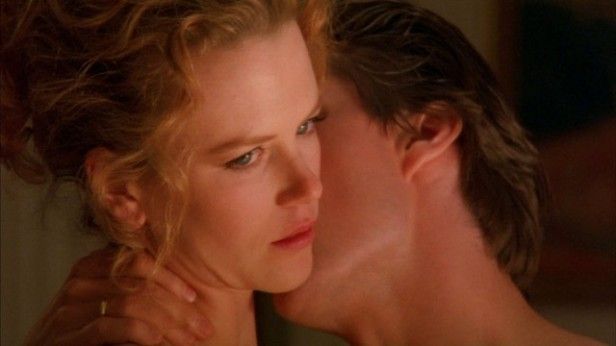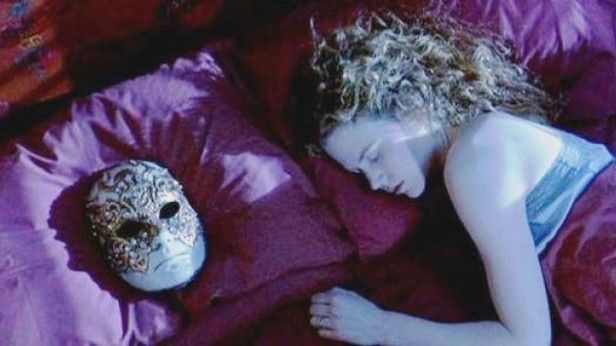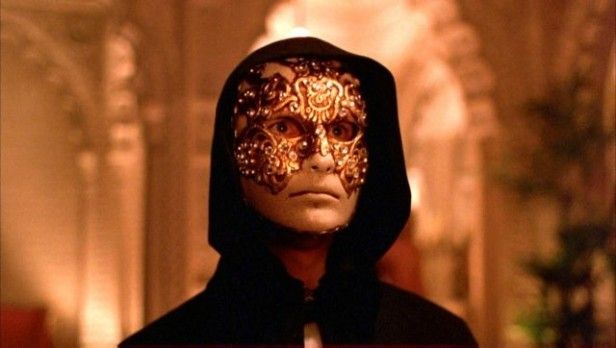July 27, 2014
Is 'Eyes Wide Shut' the Movie Stanley Kubrick Wanted Us to See?

Down to the Wire
Stanley Kubrick, probably more than any other director, was known for his almost compulsive attention to detail. A veteran chess player and strategist, Kubrick personally devised complex filing systems to solve the problems he encountered during filmmaking, and left archives that were staggering in volume and breadth, and were the subject of an excellent documentary:http://vimeo.com/78314194
He was also known for making changes to his films up to, and after, their theatrical release. After 2001: A Space Odyssey tested poorly with audiences:
Kubrick -- decided to tighten the film, cutting 19 minutes of film, explaining, "It does take a few runnings to decide finally how long things should be, especially scenes which do not have narrative advancement as their guideline."The film was released on April 2, 1968, but edits were made "between April 5 and 9, 1969 and detailed instructions were sent to theater owners already showing the film, in order that they might put the trims into effect." 17 of the 19 minutes of footage were recovered in 2010, and show that he added some titles to orient the audience, and cut things like, "an entire sequence of several shots in which Dave Bowman searches for the replacement antenna part in storage."
Crucially, though, he excised a prologue featuring eminent scientists, discussing the possibility of life elsewhere in the universe. The text of this segment is reproduced in the book, The Making of Kubrick's 2001, portions of which can be seen here. Had this remained in the film, it would have changed the tone of the film utterly, wrecking, in effect, what people love about the movie so much, i.e., its mystery. Kubrick chose to hold back, and his pragmatic choice not to bore a "restless" audience ended up connecting with the youth who turned the film into a pop culture phenomenon.
It's also kind of well-known that The Shining, perhaps the most obsessed-over Kubrick work (sorry, guys) has a deleted scene. An epilogue of sorts was shot, cut, and put into the release prints, then hastily removed. In the scene, we see Danny and Wendy, safe and in the hospital, where they are visited by the hotel manager Ullman. The scene would have occurred between the shot of Jack, dead in the maze, and the shot of Jack, alive in the hotel's past. It would also have been followed by a card that related how The Overlook overcame the tragedy and still remains open during its regular season. Luckily, this amazing Shining site, run by Toy Story 3 director Lee Unkrich, has the script for that scene. Here's the first page:

http://vimeo.com/35665697
Kubrick used his unprecedented creative control to enact costly surgery on his film, and because it took several days for all the prints to have the scene excised, there are people who saw the original version in the theater. It's also worth noting that in the official IMDb credits there are listings for a Nurse and a Policeman, showing just how late in the game this edit was made. Of the edit, Kubrick said:
After several screenings in London the day before the film opened in New York and Los Angeles, when I was able to see for the first time the fantastic pitch of excitement which the audience reached during the climax of the film, I decided the scene was unnecessary. It had not been possible to change all of the New York and Los Angeles prints before opening.
A Modest Proposal
So what, you say? What does this have to do with the price of an extra large popcorn with butter and a jumbo Diet Cherry Dr. Pepper? To which I would reply, nothing, but it does have a lot to do with Eyes Wide Shut, its reception, and some of the mysteries that have surrounded the film since 1999. It's well-known that Kubrick was an extremely controlling director, and demanding of his actors and capable, in Eyes Wide Shut, of staging a production that is recognized by the Guinness Book of World Records as the longest continuous production, a total of 400 days. He also reconstructed Greenwich Village in England and routinely shot over 90 takes of actions as banal as Tom Cruise walking through a door. But for all that, he was still willing to trim his film based on audience reception and the opinions of others. For a control freak, that's fairly laid-back.And what did those changes achieve? In both 2001 and The Shining, the key cuts added a mystery to the film. In both instances, Kubrick elected to remove explanation, for whatever reason (the scene in the hospital adds another layer of ambiguity, with Ullman throwing the ball to Danny). Perhaps Kubrick felt that was one layer too many, and diluted the power of the cut from frozen Jack to "frozen" Jack, trapped in Time.
http://www.youtube.com/watch?v=-fN-Xjpd-qE
As for 2001, the film worked its magic on the counterculture, something Kubrick had no intention of doing, by being visual in the extreme, and refusing any sort of explanation; the astonishing images are enough to convey his point. Though voiceover was used effectively in many of his films, a sequence meant to establish verisimilitude and plausibility would have ruined the mystery of the film, and also undercut the way the few lines of dialogue left play up humanity's seeming evolution away from language. So he elected, in both instances, to let the images speak for themselves, and in both cases, this probably saved, or at least greatly helped, the films.
http://www.youtube.com/watch?v=e-QFj59PON4
The fact that he left these scenes in for so long speaks to Kubrick's obsession with language; in Kubrick Land, language is not a means of communication, but of alienation; it's an ironic distancing voiceover, a hollow gesture, a banal pleasantry or hypocrisy with a smile. It's been noted, for instance, that Tom Cruise's first line in Eyes Wide Shut is a lie. Nicole Kidman asks him how she looks and he responds, "Perfect," when he's not even looking at her. As noted by Michael Ciment:
The banality of the dialogue between the Harfords and the Zieglers at the beginning of the film evokes the trivial conversation between the Russian cosmonauts and American cosmonauts in 2001 -- As always in Kubrick, the superficiality of the dialogue conceals the horrors ahead."

Near the end of Eyes Wide Shut, there's a scene between Tom Cruise, Sydney Pollack, and a billiard table that is both exceptionally long and, for many viewers, mystifying. To recap the plot: Tom Cruise, or Dr. Bill Harford, enraged by his wife Alice's confession of imagined infidelity, goes off on a dreamlike odyssey through New York, where his marriage is put to the test by the constant stream of strangers throwing themselves at Dr. Bill, whose face during the majority of the film is an impassive mask.
http://www.youtube.com/watch?v=H5YI6q90DAI
(Sorry, y'all, every video I could find has some weird Illuminati theme/interpretation.)
Obtaining an actual mask, he sneaks into an orgy at a mansion, is discovered, and then spends the rest of the film retracing his steps. Though it is never explicitly stated, the first half of the film is certainly dreamlike. For instance, Dr. Bill produces a wallet numerous times, and it never fails to produce cash, leading some to a reading of the film as capitalist allegory, with Tom Cruise as a social climber who is put back in his place when his rented costume and taxi give him away at the orgy. Victor Ziegler (Sydney Pollock) summons Cruise to let him know that though he might be invited to nice parties, he is just the help, the doctor called in to clean up Ziegler's messes.
The scene has confounded viewers since the film's release. At 13 minutes long, it contains a lot of subtextual niceties. (Cruise refuses some expensive scotch and Ziegler laughs because, really, that's the gesture of an equal, to whom a case of scotch means nothing; Cruise is seen drinking beer, and Pollack laughs at his osteopath's pretensions.) And the story he tells Cruise about the dead woman is obviously a lie, or is it? We never find out, but lots of people spent a lot of time analyzing the movement of the billiard balls, which probably wasn't the point. Below is the final 4 minutes of the scene, all I could find of the online:
http://www.youtube.com/watch?v=-n-ojOnrfYk
Is Ziegler telling the truth? Does it matter? I'm not suggesting that Kubrick would have excised the scene had he lived, but I strongly suspect that he would have cut it far shorter and that, as released, the film feels incomplete. Perhaps the film would work better without Pollack's glossing things over, then spelling out that there were super powerful people gettin' freaky last night and you shouldn't have seen that. But perhaps I should shut up. And while I would never presume, I think it's not outside the realm of possibility to say that, just as the presence of the mask on the pillow is never explained.

The orgy, one of the strangest sequences in Kubrick's filmography, might have been better left unexplained, with Ziegler's participation hinted at; like the deleted scene in The Shining, I'm inclined to think that in its present form it sort of lets the air out of what came before. Though, maybe that's the point. But Dr. Bill is, it is suggested, dreaming, and the orgy is a dreamlike affair, the fantasy, it could be argued, of what men like Ziegler do behind closed doors. In this interpretation, Ziegler's admission that yup, that's how we do, seems kind of silly.
We'll never know, and either way, people will be unhappy. The fun is in speculating, and celebrating the work of a great filmmaker. Conspiracy theories tend to draw jeers, and confessions of ignorance tend to draw sighs of exasperation. But don't sigh just yet! Also, if you YouTube this movie, you will learn that the obvious symbolism in the orgy scene is of the occult, meant to point you subtly to the film's ties to the illuminati, or something.
Eyes Wide Shut is two hours and 59 minutes long, and at the screening held a few days before he died, he apparently told the head of Warner Bros., Terry Semel, that the final cut would be two hours and thirty-nine minutes long. And, as this respected Kubrick site points out:
Kubrick's film was in a weird position. His contract forbids anyone from cutting his film. He alone had final cut. So while his sound editor could lay down tracks and put in music, per his guidelines, they could not actually edit the footage. Usually music and imagery is edited in tandem, not so in Eyes Wide Shut.And don't take my word for it. According to Eagle Scout and noted filmmaker David Lynch:
I really love Eyes Wide Shut. I just wonder if Stanley Kubrick really did finish it the way he wanted to before he died.

Just as they had before, critics got Eyes Wide Shut totally wrong. Inevitably, perhaps, it was read as an allegory for Tom and Nicole's marriage, and key elements of the plot were misinterpreted. Because they were the stars of the film, it was assumed that the audience was supposed to like Dr. Bill and Alice. But what if they are shallow consumerists, and the supposedly tender last line is evidence of their vapidity, shallow view of marital relations, and relief at being done with the whole business, which business included, you know, dead escorts? We'll never know.
Marketed as a big summer erotic thriller, the film about sexual anxiety and death and whatever else was savaged by critics, with former supporter Andrew Sarris writing that the film was "Ridiculously though intellectually overhyped for the very marginal entertainment, edification and titillation it provides over its somewhat turgid 159-minute running time."
But let's let a real authority have the last word. In the introduction to Kubrick: The Definitive Collection, Martin Scorsese writes:
If you go back and look at the contemporary reactions to any Kubrick picture (except the earliest ones) you'll see that his films were initially misunderstood. Then, after five or ten years came the realization that 2001 or Barry Lyndon or The Shining was like nothing else before or since.In the end, we have the movie we have. And it's a weird movie. And a flawed movie. And a great movie, in its way. It's wholly original, and like any great work of art, sticks with you. And, as the final film of one of the century's master filmmakers, this movie with so much to give, shunted aside at the time by a gleeful tabloid media, deserves a critical reappraisal. In the end, Eyes Wide Shut is almost certainly not the film Kubrick would have been happy with in the end, but we should be happy we have it.
I'm not offering any interpretations here, I just like talking about movies. And I'm not in the Illuminati. And neither was Kubrick.
No comments:
Post a Comment